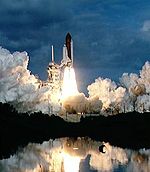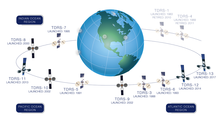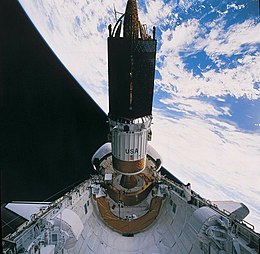|
TDRS-6
TDRS-6, known before launch as TDRS-F, is an American communications satellite, of first generation, which is operated by NASA as part of the Tracking and Data Relay Satellite System. It was constructed by TRW, and is based on a custom satellite bus which was used for all seven first generation TDRS satellites.[3] History TDRS-F was deployed from Space Shuttle Endeavour during the STS-54 mission in 1993. Endeavour was launched from Launch Complex 39B at the Kennedy Space Center, at 13:59:30 UTC on 13 January 1993.[4] TDRS-F was deployed from Endeavour around six hours after launch, and was raised to geosynchronous orbit by means of an Inertial Upper Stage.[4] DeploymentThe two-stage solid-propellent Inertial Upper Stage made two burns. The first stage burn occurred shortly after deployment from Endeavour, and placed the satellite into a geosynchronous transfer orbit (GTO). At 02:26 UTC on 14 January 1993, it reached apogee, and the second stage fired, placing TDRS-F into geosynchronous orbit.[5] At this point, it received its operational designation, TDRS-6. OperationIn 1994, it was placed at a longitude 46.0° West of the Greenwich Meridian, to serve as an on-orbit spare.[6] In 1996, it was moved to 47.0° West, where it remained until 2005, when it was repositioned to 174.0° West,[6] where, as of August 2009[update], it was used to provide communications with spacecraft in Earth orbit, such as the International Space Station (ISS) and spacecraft bringing astronauts to the ISS.   See alsoReferences
|
||||||||||||||||||||||||||||||||||||||||||||||||||||||

